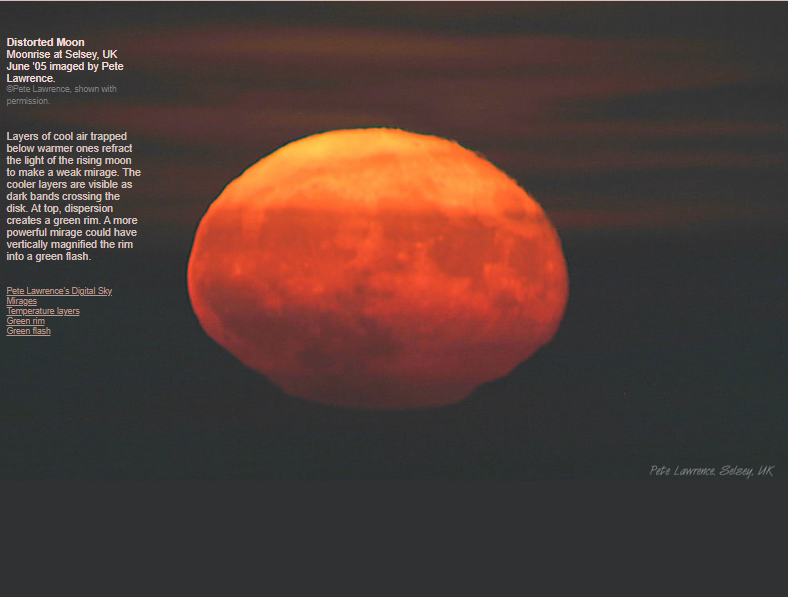Distorted Moon
Distorted Moon: Exploring the Phenomenon of Mirage
Have you ever gazed up at the night sky and noticed something peculiar about the moon? Perhaps you observed dark bands crossing its disk or a green rim around its edges. These optical anomalies are known as mirages and can create a distorted appearance of the moon. In this article, we will delve into the fascinating world of atmospheric optics to understand the science behind this captivating phenomenon.
Layers of Temperature Variations
To comprehend the occurrence of a distorted moon, we must first understand the concept of temperature layers in the atmosphere. The air surrounding us is not uniformly heated; instead, it forms layers of varying temperatures. When cooler air becomes trapped beneath warmer air, light passing through these layers can be refracted, or bent, resulting in optical illusions.
The Influence of Refraction
Refraction plays a significant role in distorting the appearance of the moon. As moonlight passes through the layers of cool and warm air, it is bent at different angles, causing the light to deviate from its original path. This bending effect leads to a mirage, where the moon appears distorted or displaced from its actual position.
Dark Bands and Green Rim
One characteristic of a distorted moon is the presence of dark bands crossing its disk. These bands represent the cooler layers of air that refract the moonlight. As the light passes through these cool layers, it gets bent in such a way that it appears as dark streaks across the moon's surface.
Additionally, a green rim may be observed around the edges of the moon during certain mirages. This green rim is a result of dispersion, which occurs when different colors of light are refracted at varying angles. The dispersion of light can separate the colors and create a green hue along the rim of the moon.
The Enigmatic Green Flash
In some instances, a mirage can intensify to create a phenomenon known as a green flash. A green flash occurs when the mirage vertically magnifies the green rim around the moon, making it more prominent and visible to the naked eye. This optical phenomenon is relatively rare and requires specific atmospheric conditions to manifest.
Captivating Examples
Photographers and skywatchers have managed to capture the beauty of distorted moons through their lenses. One such example is an image captured by Pete Lawrence in Selsey, UK in June 2005. The photograph showcases the moonrise with distinct dark bands crossing its disk and a faint green rim along its edges. These mesmerizing images serve as a testament to the wonders of atmospheric optics.
Exploring Atmospheric Optics
The phenomenon of a distorted moon is just one example of the captivating world of atmospheric optics. The atmosphere surrounding us can create an array of optical illusions and phenomena, each with its unique characteristics. From rainbows and halos to mirages and green flashes, there is a wealth of visual marvels waiting to be discovered.
Conclusion
The distorted moon, with its dark bands and green rim, provides a captivating display of atmospheric optics in action. Temperature layers in the atmosphere cause light to refract, resulting in these mesmerizing optical illusions. By understanding the science behind these phenomena, we gain a deeper appreciation for the wonders that can be observed in the night sky. So, the next time you find yourself gazing at the moon, take a moment to appreciate the beauty of its distorted form and the secrets it reveals about our atmosphere.

Distorted Moon
Moonrise at Selsey, UK June '05 imaged by Pete Lawrence.
©Pete Lawrence, shown with permission.
Layers of cool air trapped below warmer ones refract the light of the rising moon to make a weak mirage. The cooler layers are visible as dark bands crossing the disk. At top, dispersion creates a green rim. A more powerful mirage could have vertically magnified the rim into a green flash.
Pete Lawrence's Digital Sky
Mirages
Temperature layers
Green rim
Green flash
Note: this article has been automatically converted from the old site and may not appear as intended. You can find the original article here.
Reference Atmospheric Optics
If you use any of the definitions, information, or data presented on Atmospheric Optics, please copy the link or reference below to properly credit us as the reference source. Thank you!
-
<a href="https://atoptics.co.uk/blog/distorted-moon/">Distorted Moon</a>
-
"Distorted Moon". Atmospheric Optics. Accessed on November 26, 2024. https://atoptics.co.uk/blog/distorted-moon/.
-
"Distorted Moon". Atmospheric Optics, https://atoptics.co.uk/blog/distorted-moon/. Accessed 26 November, 2024
-
Distorted Moon. Atmospheric Optics. Retrieved from https://atoptics.co.uk/blog/distorted-moon/.